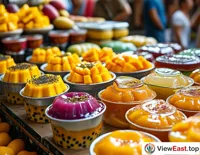







A: The Culture and Charm of Mango Pudding
Mango pudding, a dessert that blends tropical flavors with modern dessert-making techniques, has become one of the most popular desserts in the summer with its refreshing fruity aroma and smooth texture. It is not just a dessert but also a cultural expression, representing the pursuit of natural flavors and the advocacy of a healthy lifestyle.
Cultural Background:
The mango, originally from India and later spread to Southeast Asia, South Asia, and other tropical regions, is a representative of tropical fruits. Mango pudding combines the sweetness of mango with the smoothness of pudding, becoming a sweet envoy of cultural exchange, loved by people from different cultural backgrounds.
Suitable Groups:
Mango pudding is suitable for all age groups, especially those who have a particular fondness for fresh fruit flavors. As mangoes are rich in vitamins and minerals, this dessert is not only delicious but also has certain health benefits.
Features and Taste:
The feature of mango pudding lies in its rich mango flavor and delicate texture. It usually contains a large amount of fresh mango flesh, giving the pudding a natural golden yellow color and sweet fruit aroma. In terms of taste, it is sweet but not greasy, with a soft texture, beloved by dessert lovers.
Appearance:
In terms of appearance, mango pudding attracts the eye with its bright color and smooth surface. Sometimes it is decorated with fresh mango cubes or mint leaves on the surface, adding visual and taste layers.
Nutritional Value:
Mango pudding is mainly made from milk, sugar, eggs, and mangoes, and is rich in vitamins A, C, and dietary fiber. The antioxidants in mangoes help to boost immunity, and moderate consumption is beneficial to health.
B: The Process of Making Mango Pudding
Introduction to Ingredients:
The main ingredients needed to make mango pudding include: fresh mangoes, milk, sugar, eggs, and gelatin sheets or powder.
Tools Required:
The tools needed to make mango pudding include: a mixer, a sifter, measuring cups, measuring spoons, pudding molds, and an oven or steamer.
Preparation of Ingredients:
Peel and pit the fresh mangoes and cut them into small pieces.
Soak the gelatin sheets in cold water to soften them.
Cooking Steps:
Mix milk and sugar and heat until the sugar is completely dissolved.
Beat the eggs and slowly add them to the milk, stirring continuously.
Add mango puree and stir well.
Squeeze excess water from the softened gelatin sheets and add them to the milk-mango mixture, stirring until completely dissolved.
Strain the mixture to remove any impurities and ensure a smooth texture.
Pour the mixture into pudding molds and refrigerate until set.
Seasoning Tips:
The choice of mango can be adjusted according to personal taste; ripe mangoes have a richer flavor.
The amount of gelatin can be adjusted based on the desired firmness of the pudding.
Serving Suggestions:
Mango pudding is best enjoyed after chilling to maintain the best texture.
It can be paired with other tropical fruits or ice cream to create different dining experiences.